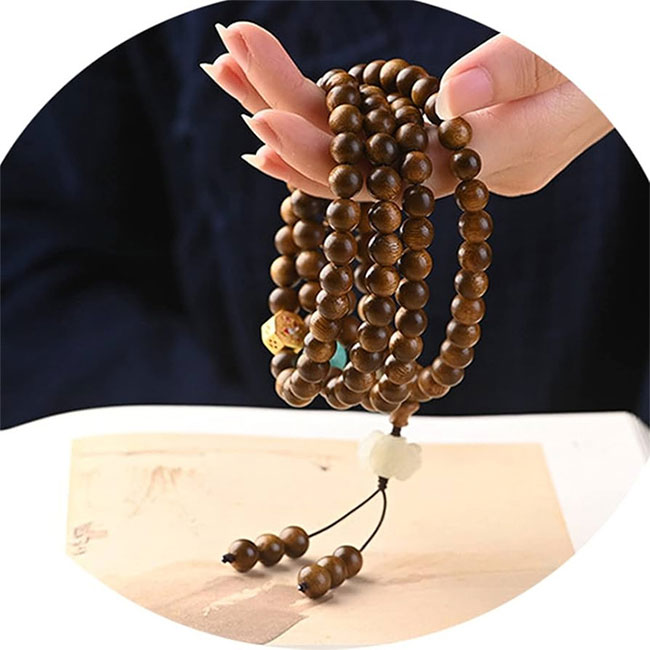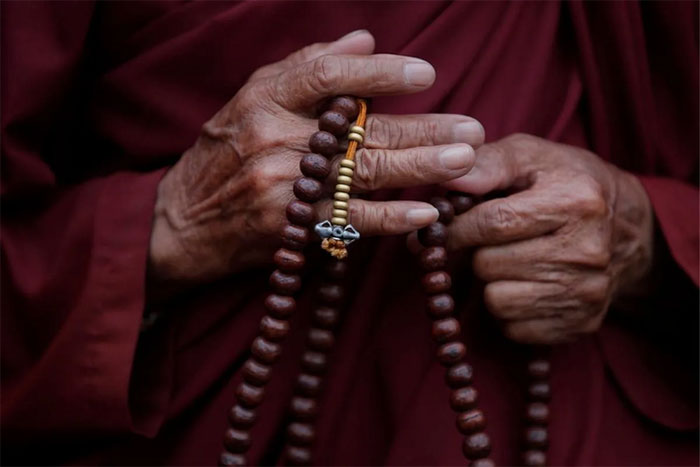Why does a rosary have 108 beads and not 100?
The rosary beads still used when chanting usually have 108 beads, not a full hundred. Why is that?
The 108-bead rosary is also known as a 'Japa mala' in Tibetan. It has been used since ancient times in both Buddhism and Hinduism for chanting. Rosary beads can be made from a variety of materials, including sandalwood, bodhi seeds, linden wood, amber, coral, jade, bone, silk, cotton, fiber, and even hemp.
Why a long rosary has 108 beads
The wrist-wort type has 16 to 19 beads; some Chinese rosaries have only 18 beads. In Mahayana Buddhism, 27-bead rosaries are also common. The largest rosary usually has 108 beads , not the exact 100. There are several explanations for this.

Rosary.
Explanation according to the function of prayer
Rosary beads are often used to count the number of times a mantra is recited . While reciting, one runs one's finger over each bead. In Vajrayana Buddhism , the 108 beads on a rosary are usually used to recite a mantra 100 times, with the extra 8 beads reserved for mistakes. Another explanation is that of the 108 beads, 100 are used to recite mantras for oneself, and the remaining 8 are used to pray for all sentient beings.
A rosary with a sufficient number of beads will help the person reciting the mantra to concentrate more, without being distracted when having to follow and count the number of times they have been recited.

Rosary beads are used to count the number of times you recite mantras and sutras. (Photo: 3 Ports).
Explanation according to the Sutra of Moc Hoan Tu
The origin of the rosary and the act of running your fingers through the rosary while reciting the Buddha's name is also said to have come from the Buddha's teachings to King Pa-Liu-Li, recorded in the Sutra of the Wood-Eyed One. The sutra records that once the Buddha and his followers traveled to Mount Ksitigarbha in the country of La-Due-Ky. The king of that place (named Pa-Liu-Li) sent a messenger to ask the Buddha to have mercy and give him an easy way to practice so that he could soon be free from afflictions.
The Buddha taught that to eliminate afflictions, one should string a 108-bead rosary made from the seeds of the cymbidium tree and always carry it with one. When walking, sitting or lying down, one should concentrate on reciting the Buddha, Dharma and Sangha, counting one bead at a time, and so on, one bead after another, until one has counted 200,000 times without the body and mind being distracted, one will feel peace and happiness. The 108-bead rosary symbolizes the attainment of the 108 Samādhis and the elimination of the 108 afflictions. When all afflictions are gone, one will be at peace.

According to the Sutra of the Flower of the Buddha, the Buddha used a 108-bead rosary long ago. (Photo: Monk Mala)
Explained in terms of enlightenment
Many people believe that the rosary has 108 beads because humans must overcome 108 afflictions on the way to enlightenment. The afflictions of living beings come from the 6 senses (eyes, ears, nose, tongue, body, mind), 6 objects (form, sound, smell, taste, touch, dharma), 6 consciousnesses (seeing, hearing, smelling, tasting, touching, consciousness), which together make 18 realms (eighteen realms).
Multiplying this number 18 by the six basic afflictions (greed, anger, ignorance, pride, doubt, and wrong views) will result in the number 108 afflictions. To attain true happiness, one must eliminate all afflictions through the process of practice, which is why a rosary has 108 beads and not 100.
- The smart necklace keeps track of recollections
- Detection of BW-1 virus eating sulfate and producing 2 different types of magnetic beads
- Alarm micro plastic beads in beer
- The LHC finds legendary beads
- The eminent physicist, the father of the phrase
- Explore the surface of the Moon
- The danger when mosquitoes today carry plastic particles in the body
- Video: What happens when you swim in a pool full of pearl beads?
- Adding the call to change the name of 'God's seed'
- Jewelry discovered from the Stone Age in Türkiye
- WWF: The Mediterranean is about to become
- Particles of micro injections into the blood help minimize damage after a heart attack
 'Fine laughs' - Scary and painful torture in ancient times
'Fine laughs' - Scary and painful torture in ancient times The sequence of numbers 142857 of the Egyptian pyramids is known as the strangest number in the world - Why?
The sequence of numbers 142857 of the Egyptian pyramids is known as the strangest number in the world - Why? History of the iron
History of the iron What is alum?
What is alum? Unique method of preserving fresh grapes for up to 6 months by Afghans
Unique method of preserving fresh grapes for up to 6 months by Afghans  World's largest rooftop solar system
World's largest rooftop solar system  NASA spacecraft crashes after series of discoveries about alien life
NASA spacecraft crashes after series of discoveries about alien life  25,000 barrels of undissolved pesticides on the seabed
25,000 barrels of undissolved pesticides on the seabed  Two whales nearly 100km apart dive at the same time
Two whales nearly 100km apart dive at the same time  Ancient Handprints on the Qinghai-Tibet Plateau: Unique Evidence of Human Evolution
Ancient Handprints on the Qinghai-Tibet Plateau: Unique Evidence of Human Evolution 